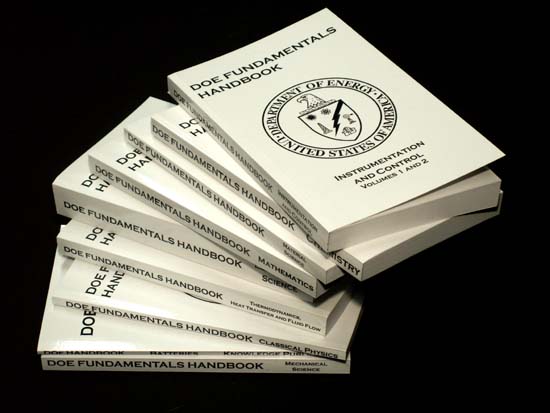Classical Physics
DOE Fundamentals Handbook - Classical Physics $13.95
The Classical Physics handbook explains crucial concepts of energy, work and power, and how to convert, measure and calculate the energy involved in various applications and experiments. It also includes other incredibly important information on the units used to measure physical properties. For example, the handbook includes how vectors are used to show the net effect of various forces; it also covers Newton's Laws of motion, and how these laws affect motion and static and dynamic forces. This information will provide YOU with a foundation for applying engineering concepts. The Classical Physics handbook presents enough information to provide YOU with a fundamental knowledge level sufficient to understand the advanced theoretical concepts presented in other subject areas and to better understand basic system and equipment operations..
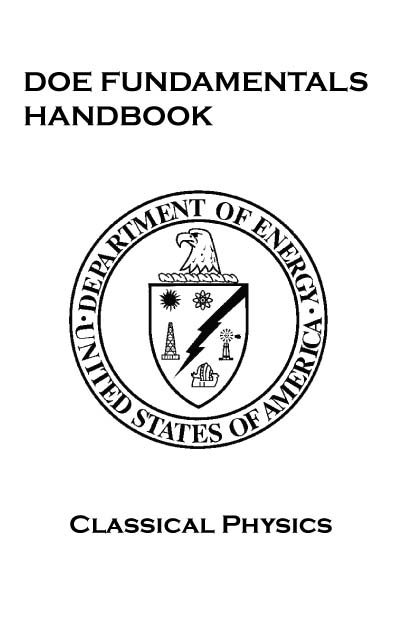
DOE Fundamentals Handbook - Classical Physics
The Department of Energy (DOE) Fundamentals Handbooks consist of ten academic subjects, which include Mathematics; Classical Physics; Thermodynamics, Heat Transfer, and Fluid Flow; Instrumentation and Control; Electrical Science; Material Science; Mechanical Science; Chemistry; Engineering Symbology, Prints, and Drawings; and Nuclear Physics and Reactor Theory. The handbooks were first published as Reactor Operator Fundamentals Manuals in 1985 for use by DOE category A reactors. The subject areas, subject matter content, and level of detail of the Reactor Operator Fundamentals Manuals were determined from several sources and prepared by the DOE Training Coordination Program. Each handbook contains an abstract, a foreword, an overview, learning objectives, and text material, and is divided into modules.
The Classical Physics Fundamentals Handbook was originally developed to assist nuclear facility operating contractors provide operators, maintenance personnel, and the technical staff with the necessary fundamentals training to ensure a basic understanding of physical forces and their properties. The handbook includes information on the units used to measure physical properties; vectors, and how they are used to show the net effect of various forces; Newton's Laws of motion, and how to use these laws in force and motion applications; and the concepts of energy, work, and power, and how to measure and calculate the energy involved in various applications. This information will provide individuals with a foundation for understanding the basic operation of various types of DOE nuclear facility systems and equipment. The knowledge in the handbook is presented to provide a foundation for applying engineering concepts. The Classical Physics handbook presents enough information to provide the reader with a fundamental knowledge level sufficient to understand the advanced theoretical concepts presented in other subject areas, and to better
understand basic system and equipment operations.
The Classical Physics handbook consists of five modules that are contained in one volume. The following is a brief description of the information presented in each module of the handbook.
Module 1 - Unit Systems
- Explanation- This module presents the concept of unit systems for the fundamental dimensions of mass, length, and time used in physics. Additionally, derivation of units and the conversion of these units is presented.
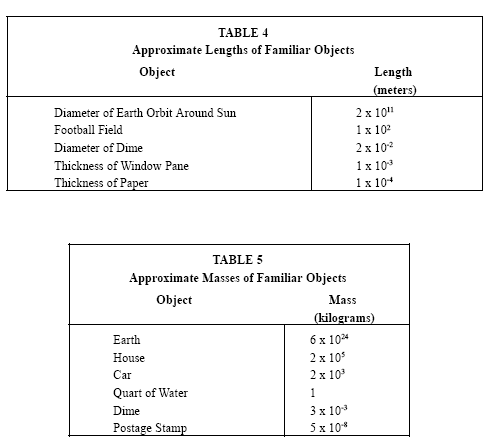
Derived Measurements
Most physical quantities have units that are combinations of the three fundamental dimensions of length, mass, and time. When these dimensions or measurements are combined, they produce what are referred to as derived units. This means that they have been "derived" from one or more fundamental measurements. These combinations of fundamental measurements can be the combination of the same or different units. The following are examples of various derived units.
Area
Area is the product of two lengths (e.g., width x length for a rectangle); thus, it has the units of length squared, such as square inches (in.2) or square meters (m2).
1mx1m=1m2
4 in. x 2 in. = 8 in.2
Volume
Volume is the product of three lengths (e.g., length x width x depth for a rectangular solid); thus, it has the units of length cubed, such as cubic inches (in?) or cubic meters (m3). The MKS and CGS unit systems have a specific unit for volume called the liter (l). One liter is equal to 1000 cubic centimeters (1 l= 1000 cm3).
2 in. x 3 in. x 5 in. = 30 in.3
Density
Density is a measure of the mass of an object per unit volume; thus, it has units of mass divided by length cubed such as kilograms per cubic meter (kg/m3) or pounds per cubic foot (lbs/ft).
15 lbs/5 W = 3 lbs/fO
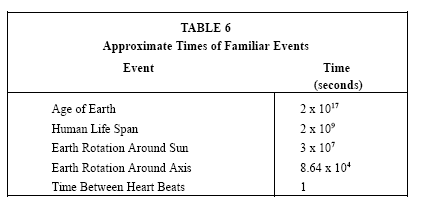 Velocity
Velocity
Velocity is the change in length per unit time; thus, it has units such as kilometers per hour (km/h) or feet per second (ft/s).
FUNDAMENTAL DIMENSIONS
Unit Systems
Derived Measurements
Summary
UNIT CONVERSIONS
Conversion Factors
Unit Conversion
Steps for Unit Conversion
Summary
Module 2 - Vectors
- Explanation- This module contains information to aid in the determination of the net effect of various forces on an object and includes graphing vectors, adding vectors, and determining component vectors of a resultant vector.
SCALAR AND VECTOR QUANTITIES
Scalar Quantities
Vector Quantities
Description of a Simple Vector
Examples of Vector Quantities
Summary
VECTOR IDENTIFICATION
In Written Materials
Graphic Representation
Graphic Representation of Vectors
Summary
VECTORS: RESULTANTS AND COMPONENTS
Resultant
Vector Components
Summary
GRAPHIC METHOD OF VECTOR ADDITION
Vector Addition
Methods Used to Add Vectors
Using the Graphic Method
Summary
COMPONENT ADDITION METHOD
An Explanation of Components
Using the Component Addition Method
Summary
ANALYTICAL METHOD OF VECTOR ADDITION
Review of Mathematical Functions
Using the Analytical Method
Summary
Module 3 - Force and Motion
-Explanation- This module presents Newton's Laws of force and motion.
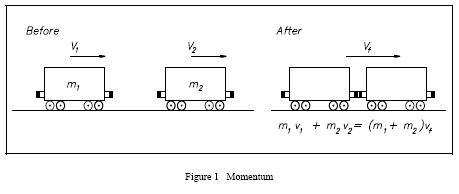
In the case where two bodies collide and have identical final velocities, equation 3-10 applies.
m1v1 + m2v2 = (m1 + m2)vf (3-10)
For example, consider two railroad cars rolling on a level, frictionless track (see Figure 1). The cars collide, become coupled, and roll together at a final velocity (vf). The momentum before and after the collision is expressed with Equation 3-10.
NEWTON'S LAWS OF MOTION
Summary
MOMENTUM PRINCIPLES
Momentum
Force and Momentum
Conservation of Momentum
Summary
Module 4 - Application of Newton's Laws
-Explanation- This module describes the effect of static and dynamic forces on objects and includes a discussion of the forces commonly encountered in a nuclear facility.

The frictional force (FK) is a force that opposes the direction of motion. This force is explained in more detail in the chapter on types of forces.
To solve this practical problem, assign values for each force as determined by data given in the problem. After assigning a sign convention (e.g., + for forces upward and to the right, - for forces downward and to the left), sum all forces to find the net force acting on the body. Using this net force information and appropriate equations, solve for the requested unknowns. A variation would be to find an unknown force acting on the body given sufficient information about the other forces acting on the body. The student will learn to solve specific examples using free-body diagrams in a later chapter.
Some advanced free-body diagrams for various types of systems are shown in Figure 4.
FORCE AND WEIGHT
Introduction
Force
Weight
Summary
FREE-BODY DIAGRAMS
Constructing a Free-Body Diagram
Summary
FORCE EQUILIBRIUM
Net Force
Equilibrium
Summary
TYPES OF FORCE
Tensile and Compressive Forces
Friction
Centripetal Force
Centrifugal Force
Summary
Module 5 - Energy, Work, and Power
-Explanation- This module defines energy, work, and power, identifies their various forms, and discusses the conservation of energy, work, and power including the measurement and calculation of each.
ENERGY AND WORK
Energy
Potential Energy
Kinetic Energy
Thermal Energy
Mechanical Energy
Work
Summary
LAW OF CONSERVATION OF ENERGY
Conservation of Energy
Summary
POWER
Power
Thermal Power
Mechanical Power
Summary

DOE Fundamentals Handbook - Classical Physics $13.95
The Classical Physics handbook explains crucial concepts of energy, work and power, and how to convert, measure and calculate the energy involved in various applications and experiments. It also includes other incredibly important information on the units used to measure physical properties. For example, the handbook includes how vectors are used to show the net effect of various forces; it also covers Newton's Laws of motion, and how these laws affect motion and static and dynamic forces. This information will provide YOU with a foundation for applying engineering concepts. The Classical Physics handbook presents enough information to provide YOU with a fundamental knowledge level sufficient to understand the advanced theoretical concepts presented in other subject areas and to better understand basic system and equipment operations.
